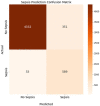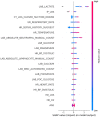Development and validation of a machine learning model integrated with the clinical workflow for early detection of sepsis
- PMID: 38076259
- PMCID: PMC10701904
- DOI: 10.3389/fmed.2023.1284081
Development and validation of a machine learning model integrated with the clinical workflow for early detection of sepsis
Abstract
Background: Sepsis is a life-threatening condition caused by a dysregulated response to infection, affecting millions of people worldwide. Early diagnosis and treatment are critical for managing sepsis and reducing morbidity and mortality rates.
Materials and methods: A systematic design approach was employed to build a model that predicts sepsis, incorporating clinical feedback to identify relevant data elements. XGBoost was utilized for prediction, and interpretability was achieved through the application of Shapley values. The model was successfully deployed within a widely used Electronic Medical Record (EMR) system.
Results: The developed model demonstrated robust performance pre-operations, with a sensitivity of 92%, specificity of 93%, and a false positive rate of 7%. Following deployment, the model maintained comparable performance, with a sensitivity of 91% and specificity of 94%. Notably, the post-deployment false positive rate of 6% represents a substantial reduction compared to the currently deployed commercial model in the same health system, which exhibits a false positive rate of 30%.
Discussion: These findings underscore the effectiveness and potential value of the developed model in improving timely sepsis detection and reducing unnecessary alerts in clinical practice. Further investigations should focus on its long-term generalizability and impact on patient outcomes.
Keywords: XGBoost; early detection; machine learning; machine learning deployment; model interpretability; sepsis.
Copyright © 2023 Mahyoub, Yadav, Dougherty and Shukla.
Conflict of interest statement
The authors declare that the research was conducted in the absence of any commercial or financial relationships that could be construed as a potential conflict of interest.
Figures







Similar articles
-
Development and validation of a machine learning model integrated with the clinical workflow for inpatient discharge date prediction.Front Digit Health. 2024 Sep 30;6:1455446. doi: 10.3389/fdgth.2024.1455446. eCollection 2024. Front Digit Health. 2024. PMID: 39403613 Free PMC article.
-
Real-Time Prediction of Sepsis in Critical Trauma Patients: Machine Learning-Based Modeling Study.JMIR Form Res. 2023 Mar 31;7:e42452. doi: 10.2196/42452. JMIR Form Res. 2023. PMID: 37000488 Free PMC article.
-
Prediction of In-hospital Mortality in Emergency Department Patients With Sepsis: A Local Big Data-Driven, Machine Learning Approach.Acad Emerg Med. 2016 Mar;23(3):269-78. doi: 10.1111/acem.12876. Epub 2016 Feb 13. Acad Emerg Med. 2016. PMID: 26679719 Free PMC article.
-
Machine Learning-Based Early Prediction of Sepsis Using Electronic Health Records: A Systematic Review.J Clin Med. 2023 Aug 30;12(17):5658. doi: 10.3390/jcm12175658. J Clin Med. 2023. PMID: 37685724 Free PMC article. Review.
-
Deployment of machine learning algorithms to predict sepsis: systematic review and application of the SALIENT clinical AI implementation framework.J Am Med Inform Assoc. 2023 Jun 20;30(7):1349-1361. doi: 10.1093/jamia/ocad075. J Am Med Inform Assoc. 2023. PMID: 37172264 Free PMC article.
Cited by
-
Machine Learning and Deep Learning Models for Early Sepsis Prediction: A Scoping Review.Indian J Crit Care Med. 2025 Jun;29(6):516-524. doi: 10.5005/jp-journals-10071-24986. Epub 2025 Jun 5. Indian J Crit Care Med. 2025. PMID: 40567322 Free PMC article. Review.
-
Development and validation of a machine learning model integrated with the clinical workflow for inpatient discharge date prediction.Front Digit Health. 2024 Sep 30;6:1455446. doi: 10.3389/fdgth.2024.1455446. eCollection 2024. Front Digit Health. 2024. PMID: 39403613 Free PMC article.
References
-
- Fleischmann-Struzek C, Mellhammar L, Rose N, Cassini A, Rudd KE, Schlattmann P, et al. . Incidence and mortality of hospital-and ICU-treated sepsis: results from an updated and expanded systematic review and meta-analysis. Intensive Care Med. (2020) 46:1552–62. doi: 10.1007/s00134-020-06151-x, PMID: - DOI - PMC - PubMed
LinkOut - more resources
Full Text Sources

